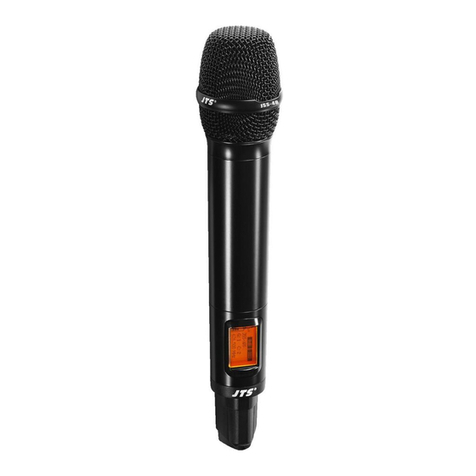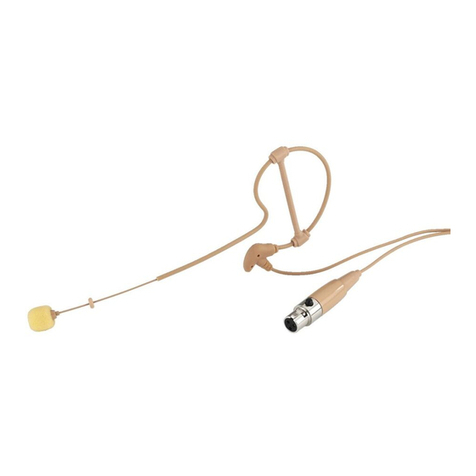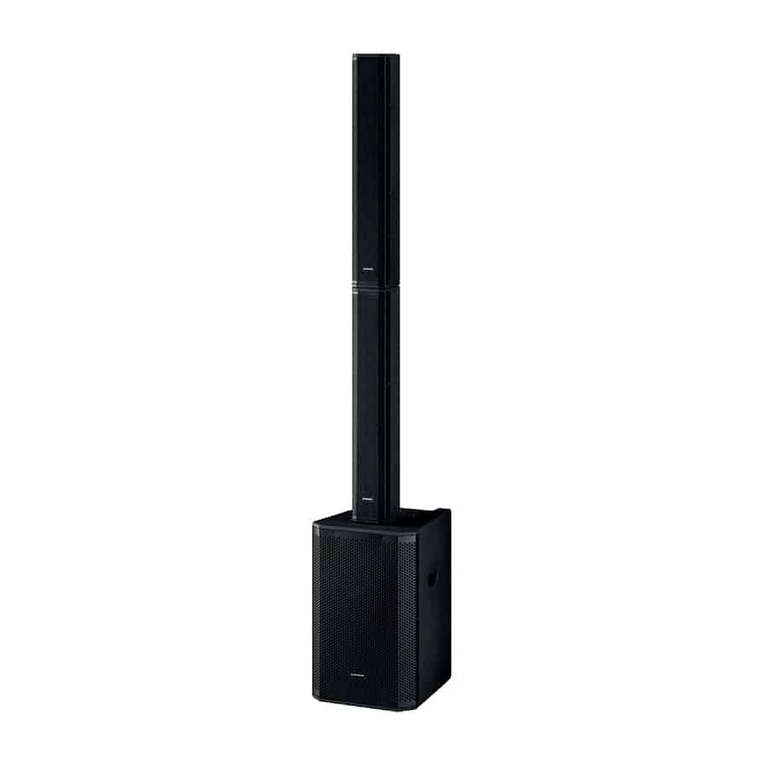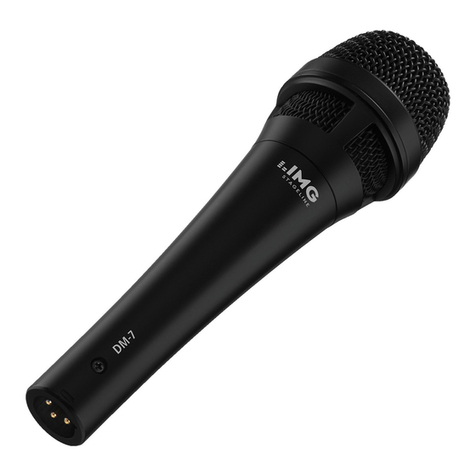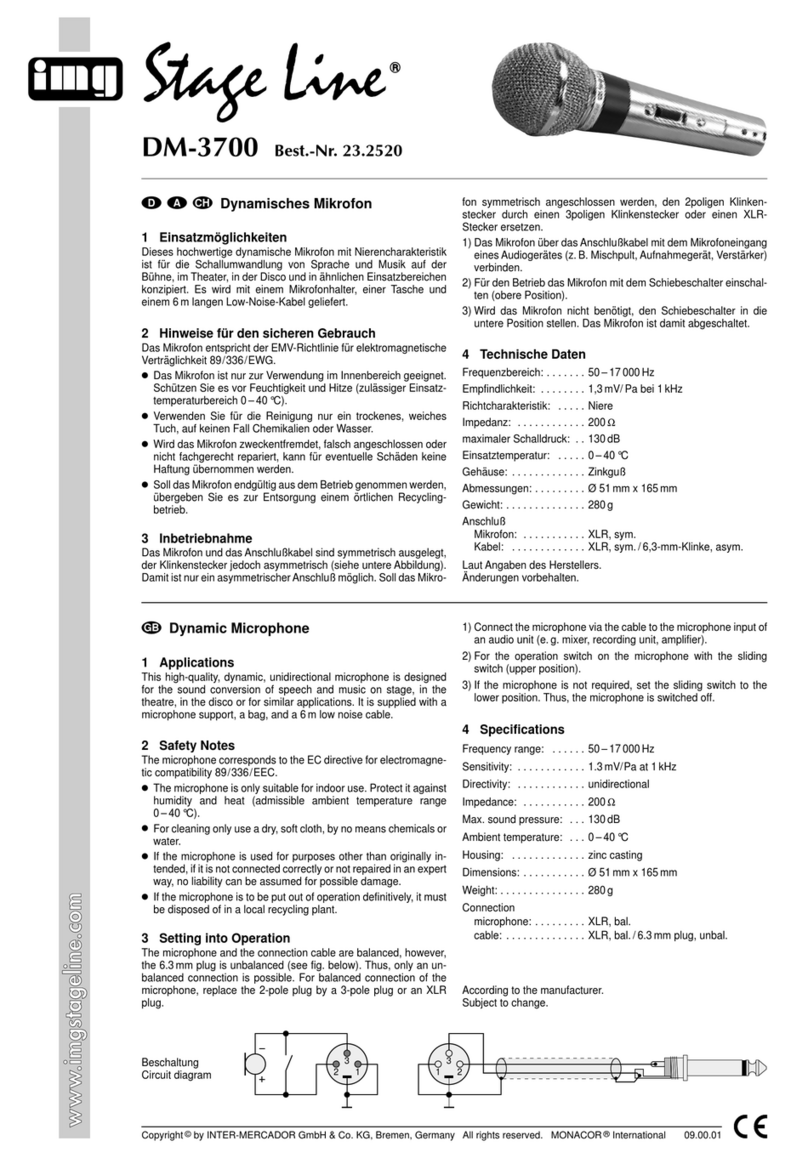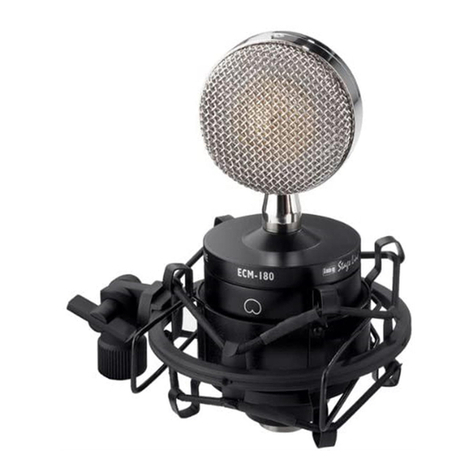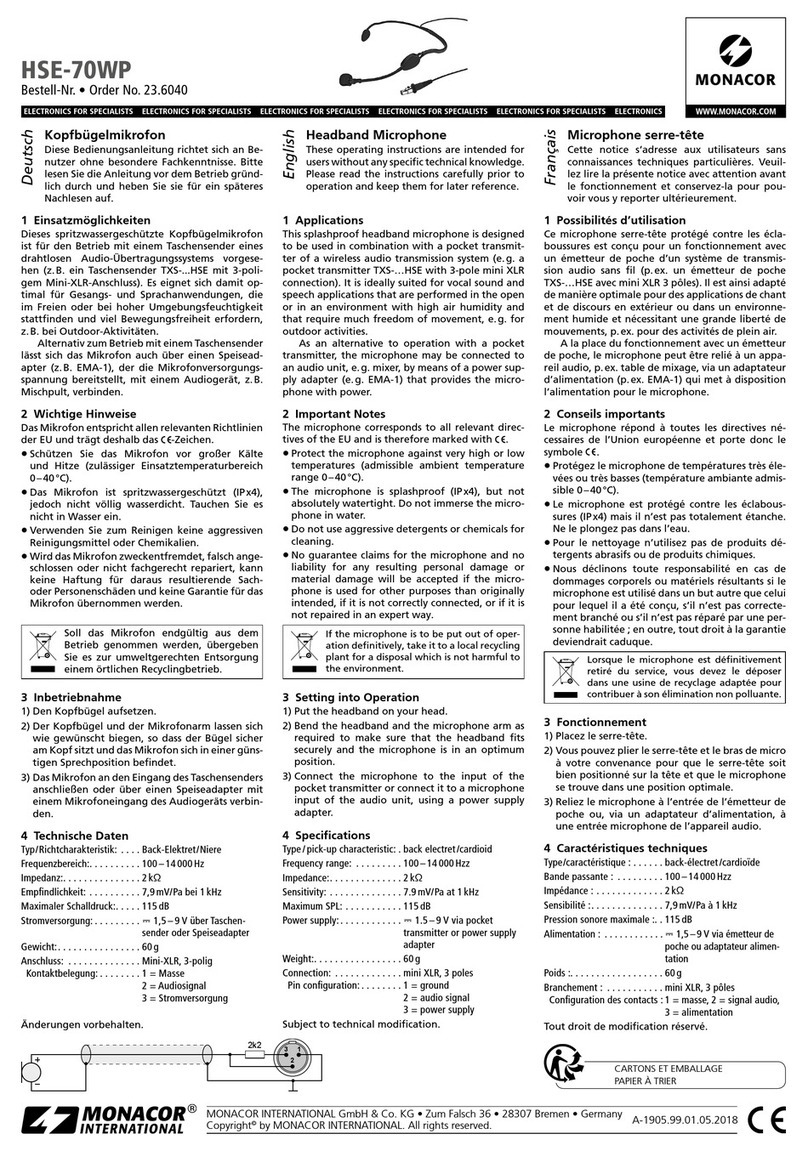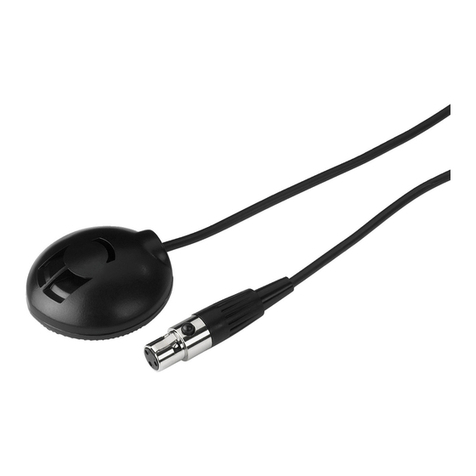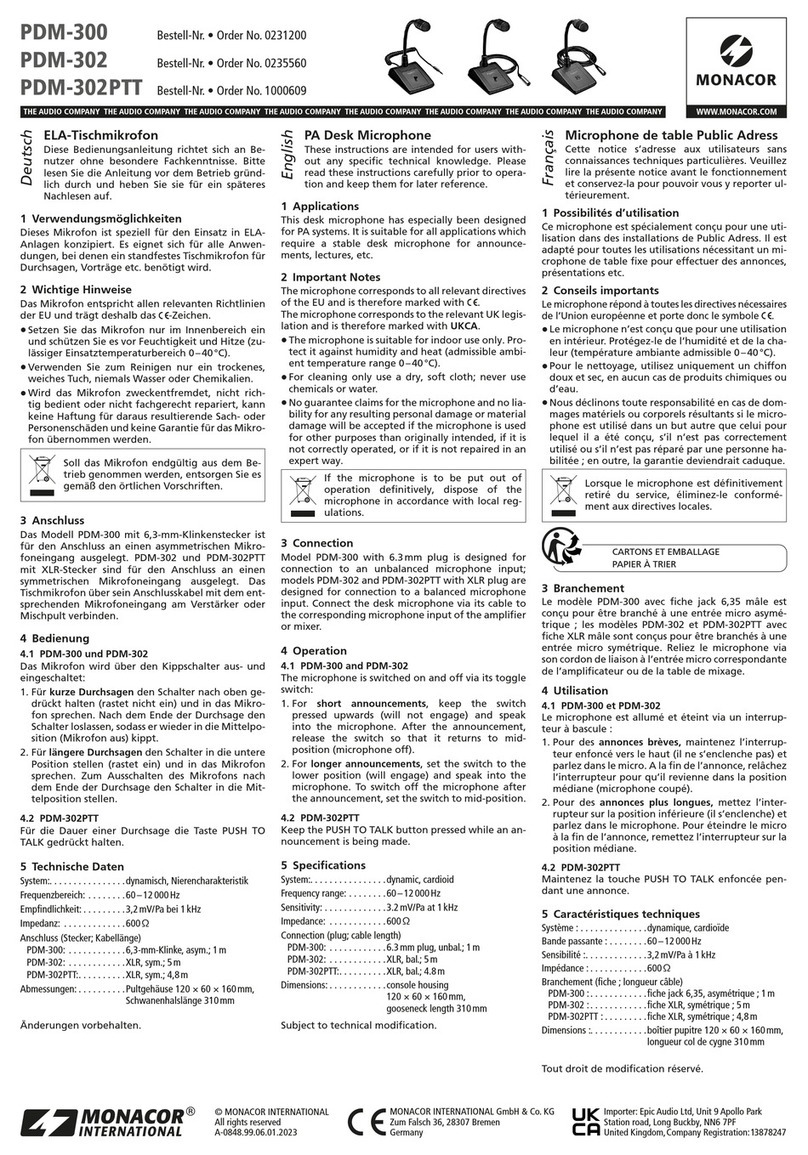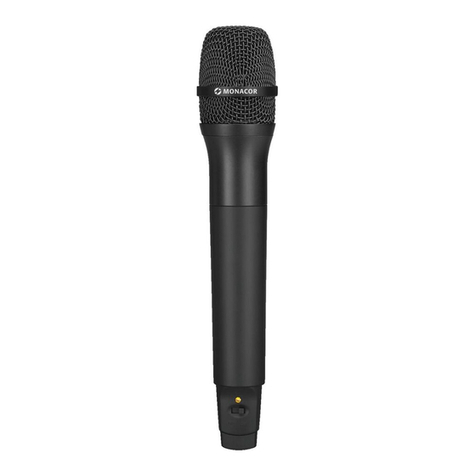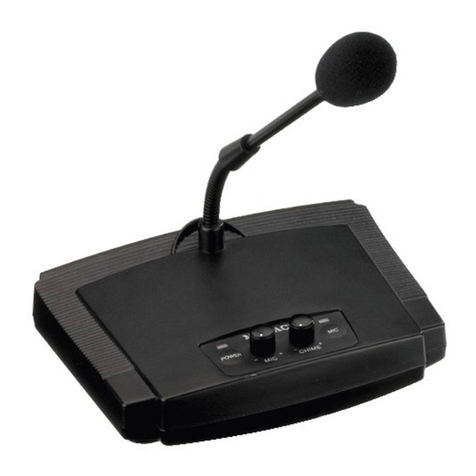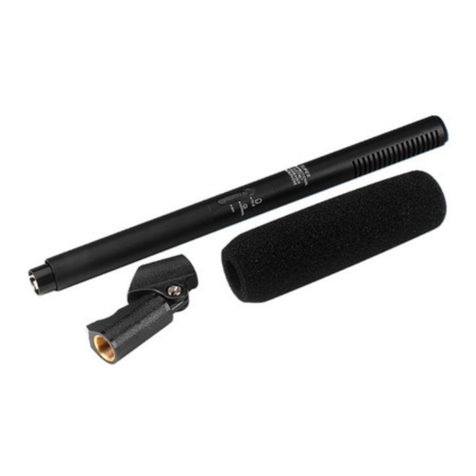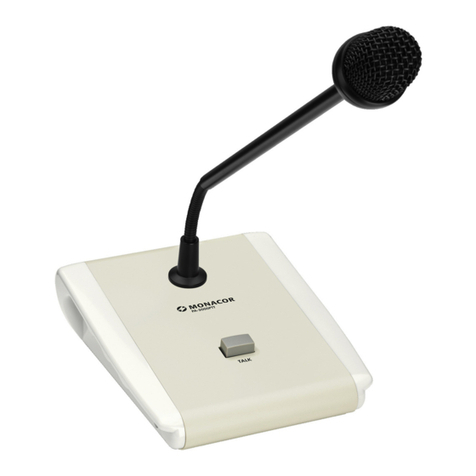DM -1800
Bestellnummer 23.6330
Microphone dynamique
Veuillez lire la présente notice avec attention
avant le fonctionnement et conservez-la pour
pouvoir vous y reporter ultérieurement.
1 Possibilités dʼutilisation
Le microphone dynamique DM-1800, cardioïde,
est adapté pour des applications de chant et de
discours sur scène, dans un théâtre, une disco-
thèque etc. Il est livré avec un support micro et
un cordon de branchement Low Noise de 5 m.
2 Conseils importants dʼutilisation
Le microphone répond à toutes les directives
nécessaires de lʼUnion européenne et porte
donc le symbole .
GLe microphone nʼest conçu que pour une utili-
sation en intérieur. Protégez-le de tout type de
projections d'eau, des éclaboussures, d'une
humidité élevée de l'air et de la chaleur (plage
de température de fonctionnement autorisée :
0 – 40 °C).
GPour le nettoyage, utilisez uniquement un
chiffon sec et doux, en aucun cas de produits
chimiques ou d'eau.
GNous déclinons toute responsabilité en cas de
dommages matériels ou corporels résultants
si le microphone est utilisé dans un but autre
que celui pour lequel il a été conçu, s'il n'est
pas correctement branché ou s'il n'est pas
réparé par une personne habilitée ; en outre,
la garantie deviendrait caduque.
3 Fonctionnement
1) Vissez le support micro sur un pied micro
doté dʼun filetage 15,9 mm (5⁄8″) et placez le
microphone dans le support.
2) Reliez le microphone à lʼentrée micro dʼun
appareil audio (par exemple table de mixage,
enregistreur, amplificateur) via le cordon de
branchement. Le microphone et le cordon de
branchement sont symétriques.
3) Pour allumer le microphone, poussez lʼinter-
rupteur vers le haut.
4) Pour éviter tout effet de larsen, assurez-vous
que le microphone nʼest pas tenu trop près
Lorsque le microphone est définitive-
ment retiré du service, vous devez le
déposer dans une usine de recyclage
adaptée pour contribuer à son élimina-
tion non polluante.
dʼune enceinte, nʼest pas dirigé vers elle et que
le volume nʼest pas réglé trop fort. Si besoin,
diminuez le volume pour le microphone sur
lʼamplificateur ou la table de mixage.
4 Caractéristiques techniques
Type transducteur : . . . . dynamique
Directivité : . . . . . . . . . . . cardioïde
Bande passante : . . . . . . 60 – 14 000 Hz
Pression sonore max. : . 130 dB
Sensibilité : . . . . . . . . . . 2,8 mV/Pa à 1 kHz
Impédance : . . . . . . . . . . 630 Ω
Corps : . . . . . . . . . . . . . . fonte métallique
Branchement : . . . . . . . . XLR, symétrique
Configuration
contacts : . . . . . . . . . . 1 = blindage
2 = signall +
3 = signal
-
Cordon branchement : cordon Low Noise
5 m avec fiches XLR
Dimension : . . . . . . . . . . ∅46 mm × 170 mm
Poids : . . . . . . . . . . . . . . 600 g
Tout droit de modification réservé.
Microfono dinamico
Vi preghiamo di leggere attentamente le pre-
senti istruzioni prima della messa in funzione e
di conservarle per un uso futuro.
1 Possibilità d'impiego
Il microfono dinamico DM-1800 con caratteri-
stica a cardioide è adatto in modo ottimale per
applicazioni di canto e di lingua parlata sul pal-
coscenico, a teatro, in discoteca ecc. Sono in
dotazione un porta microfono e un cavo low
noise di 5 m.
2 Avvertenze importanti per l'uso
Il microfono è conforme a tutte le direttive rile-
vanti dellʼUE e pertanto porta la sigla .
GUsare il microfono solo allʼinterno e proteggerlo
dall'acqua gocciolante e dagli spruzzi d'acqua,
da alta umidità dell'aria e dal calore (tempera-
tura dʼimpiego ammessa fra 0 e 40 °C).
GPer la pulizia usare solo un panno morbido,
asciutto; non impiegare in nessun caso acqua
o prodotti chimici.
GNel caso dʼuso improprio, di collegamento
sbagliato o di riparazione non a regola dʼarte
del microfono, non si assume nessuna re-
sponsabilità per eventuali danni consequen-
ziali a persone o a cose e non si assume nes-
suna garanzia per l'apparecchio.
3 Messa in funzione
1) Avvitare il porta microfono su uno stativo per
microfono con filettatura 15,9 mm (5⁄8″) e inse-
rire il microfono nel suo supporto.
2) Collegare il microfono con l'ingresso di un
apparecchio audio (p. es. mixer, registratore,
amplificatore) usando il cavo in dotazione. Il
microfono e il cavo di collegamento sono con
contatti bilanciati.
3) Per accendere il microfono spostare in alto
l'interruttore.
4) Per evitare il fischio del feedback fare atten-
zione che il microfono non si trovi troppo
vicino all'altoparlante, che non sia orientato
verso l'altoparlante e che il volume non sia
Se si desidera eliminare l'apparecchio
definitivamente, consegnarlo per lo
smaltimento a un'istituzione locale per
il riciclaggio.
troppo alto. Se necessario, sull'amplificatore
o sul mixer ridurre il volume per il microfono.
4 Dati tecnici
Tipo di trasduttore: . . . . dinamico
Caratteristica: . . . . . . . . cardioide
Gamma di frequenze: . . 60 – 14 000 Hz
Pressione sonora max.: 130 dB
Sensibilità: . . . . . . . . . . 2,8 mV/Pa con 1 kHz
Impedenza: . . . . . . . . . 630 Ω
Corpo: . . . . . . . . . . . . . metallo pressofuso
Contatti: . . . . . . . . . . . . XLR, bilanciati
Piedinatura: . . . . . . . 1 = schermo
2 = segnale +
3 = segnale
-
Cavo di
collegamento: . . . . . . cavo low noise di 5 m
con contatti XLR
Dimensioni: . . . . . . . . . ∅46 mm × 170 mm
Peso: . . . . . . . . . . . . . . 600 g
Con riserva di modifiche tecniche.
®
MONACOR INTERNATIONAL GmbH & Co. KG
•
Zum Falsch 36
•
28307 Bremen
•
Germany
Copyright
©
by MONACOR INTERNATIONAL. All rights reserved. A-1483.99.01.12.2013
